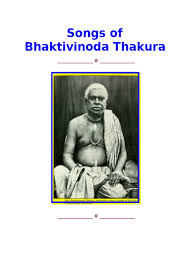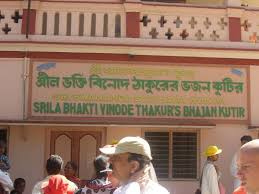
Though we need to make judgments when holding people accountable, we needn’t become judgmental.
Websites from the ISKCON Universe
A video by ISKCON Desire Tree.
The post Bhakti Yoga – Becoming Debt Free by Complete Surrender appeared first on ISKCON News.
Mantra Fest, Green Concert Club, Moscow, Russia, September 1st, 2019.
The post ‘Vande Krishna – Sweetheart of the Gopis’ by Jahnavi Harrison MantraFest Live appeared first on ISKCON News.
In the darkness of COVID-19, with devotees around the world under stay-at-home orders for months on end, virtual programs have brought much needed inspiration and association. One of the stand out bright spots has been the Towaco Zoom Sangas. Organized by ISKCON of New Jersey’s Towaco temple in the USA, the program has delivered talks […]
The post Towaco Zoom Sangas A Bright Spot in the Darkness of the Pandemic appeared first on ISKCON News.
 “While teaching Rupa Gosvami, Sri Caitanya Mahaprabhu said, guru-krishna-prasade paya bhakti-lata-bija: one can achieve the seed of devotional service by the mercy of the guru, the spiritual master, and then by the mercy of Krishna. This is the secret of success. First one should try to please the spiritual master, and then one should attempt to please the Supreme Personality of Godhead. Visvanstha Cakravarti Thakura also says, yasya prasadad bhagavat-prasado. One should not attempt to please the Supreme Personality of Godhead by concoction. One must first be prepared to serve the spiritual master, and when one is qualified he is automatically offered the platform of direct service to the Lord.” Srimad-Bhagavatam 7.9.28 purport.
“While teaching Rupa Gosvami, Sri Caitanya Mahaprabhu said, guru-krishna-prasade paya bhakti-lata-bija: one can achieve the seed of devotional service by the mercy of the guru, the spiritual master, and then by the mercy of Krishna. This is the secret of success. First one should try to please the spiritual master, and then one should attempt to please the Supreme Personality of Godhead. Visvanstha Cakravarti Thakura also says, yasya prasadad bhagavat-prasado. One should not attempt to please the Supreme Personality of Godhead by concoction. One must first be prepared to serve the spiritual master, and when one is qualified he is automatically offered the platform of direct service to the Lord.” Srimad-Bhagavatam 7.9.28 purport.
The Secret for Success in Spiritual Life (Right click to download)
Podcast
The post The Monk’s Podcast 10 – Where is God amid crisis appeared first on The Spiritual Scientist.
Podcast
Video:
The post The Monk’s Podcast 9 – Is the world a stage appeared first on The Spiritual Scientist.
Podcast
Video:
The post The Monk’s Podcast 8 – Rituals – what they are and why they matter appeared first on The Spiritual Scientist.
Podcast
Video:
The post The Monk’s Podcast 7 – Environmentalism and Bhakti appeared first on The Spiritual Scientist.
 “This material world is certified by the Lord in the Bhagavad-gita as a dangerous place full of calamities. Less intelligent persons prepare plans to adjust to those calamities without knowing that the nature of this place is itself full of calamities. They have no information of the abode of the Lord, which is full of bliss and without trace of calamity. The duty of the sane person, therefore, is to be undisturbed by worldly calamities, which are sure to happen in all circumstances. Suffering all sorts of unavoidable misfortunes, one should make progress in spiritual realization because that is the mission of human life.” Srimad-Bhagavatam 1.8.25 purport.
“This material world is certified by the Lord in the Bhagavad-gita as a dangerous place full of calamities. Less intelligent persons prepare plans to adjust to those calamities without knowing that the nature of this place is itself full of calamities. They have no information of the abode of the Lord, which is full of bliss and without trace of calamity. The duty of the sane person, therefore, is to be undisturbed by worldly calamities, which are sure to happen in all circumstances. Suffering all sorts of unavoidable misfortunes, one should make progress in spiritual realization because that is the mission of human life.” Srimad-Bhagavatam 1.8.25 purport.
The Spirit Soul is Transcendental to all Material Calamities (Right click to download)
Giriraj Swami read and spoke from Srimad-Bhagavatam 7.5.12.
“Everyone should be friendly for the service of the Lord. Everyone should praise another’s service to the Lord and not be proud of his own service. This is the way of Vaisnava thinking, Vaikuntha thinking. There may be rivalries and apparent competition between servants in performing service, but in the Vaikuntha planets the service of another servant is appreciated, not condemned. This is Vaikuntha competition. There is no question of enmity between servants. Everyone should be allowed to render service to the Lord to the best of his ability, and everyone should appreciate the service of others. Such are the activities of Vaikuntha . Since everyone is a servant, everyone is on the same platform and is allowed to serve the Lord according to his ability.” Srimad-Bhagavatam 7.5.12 purport.
As Servants of the Lord, We Are One (Right click to download)
Broadcast from ISKCON’s World Headquarters in Sridhama Mayapur, the education capital of the world, this bi-weekly webinar will flood the world with the dissemination of devotional and organizational subject-matter of the highest quality by devotee speakers highly regarded in their expertise, in a systematic and effective way through the ZOOM live video conferencing program and format, to be utilized by devotees worldwide for their personal and extended benefit.
The first program is scheduled for June 5th at 10:00am (US-EST)/7:30pm (IST) and will feature H.G. Ambarisa prabhu speaking on the subject of Wisdom and Wealth. Below is the Zoom registration information and you are encouraged to sign up soon as there is limited live capacity. Live viewers will be able to send in questions. A live feed will also be connected to the Temple of the Vedic Planetarium – TOVP Facebook Page. All programs will also be archived on the TOVP website and YouTube Channel: https://www.youtube.com/user/TOVPinfo
Zoom Registration Information :
You are invited to a Zoom webinar.
When : Jun 5, 2020 07:30 PM India/10:00 AM U.S. (EST)
Topic: Launch of TOVP TALKS/Wisdom and Wealth
Register in advance for this webinar:
https://us02web.zoom.us/webinar/register/WN_H5520W6xQyux7SPXsNanSQ
The post TOVP TALKS – Talk Show Announcement appeared first on Temple of the Vedic Planetarium.
Answer Podcast
The post Can we see adversities like the corona crisis as blessings? appeared first on The Spiritual Scientist.
Answer Podcast
The post During distress if someone turns away from Krishna and becomes an atheist, what is the role of God’s will in their misuse of free will? appeared first on The Spiritual Scientist.
Podcast
Video:
The post The Monk’s Podcast 6 – Finding inner anchor amid outer storms appeared first on The Spiritual Scientist.
 “This material world is certified by the Lord in the Bhagavad-gita as a dangerous place full of calamities. Less intelligent persons prepare plans to adjust to those calamities without knowing that the nature of this place is itself full of calamities. They have no information of the abode of the Lord, which is full of bliss and without trace of calamity. The duty of the sane person, therefore, is to be undisturbed by worldly calamities, which are sure to happen in all circumstances. Suffering all sorts of unavoidable misfortunes, one should make progress in spiritual realization because that is the mission of human life. The spirit soul is transcendental to all material calamities; therefore, the so-called calamities are called false.” Srimad-Bhagavtam 1.8.25 purport.
“This material world is certified by the Lord in the Bhagavad-gita as a dangerous place full of calamities. Less intelligent persons prepare plans to adjust to those calamities without knowing that the nature of this place is itself full of calamities. They have no information of the abode of the Lord, which is full of bliss and without trace of calamity. The duty of the sane person, therefore, is to be undisturbed by worldly calamities, which are sure to happen in all circumstances. Suffering all sorts of unavoidable misfortunes, one should make progress in spiritual realization because that is the mission of human life. The spirit soul is transcendental to all material calamities; therefore, the so-called calamities are called false.” Srimad-Bhagavtam 1.8.25 purport.
Crossing the Ocean of Nescience (Right click to download)
 My beloved, exalted disciple Kamala devi dasi left her body in Mauritius two days ago. Everything about her departure was auspicious, and her consciousness was fixed on Goloka Vrindavan. She was ably assisted in her final journey by HH Bhakti Brhat Bhagavata Swami, Karunika dasi, Vrajesvari dasi, Manasi Ganga dasi, Arcana Siddhi dasi, and her devoted daughter, Dhira Prasanta dasi, and son, Lesh, in Mauritius, and by Krsnagi dasi and others from afar.
My beloved, exalted disciple Kamala devi dasi left her body in Mauritius two days ago. Everything about her departure was auspicious, and her consciousness was fixed on Goloka Vrindavan. She was ably assisted in her final journey by HH Bhakti Brhat Bhagavata Swami, Karunika dasi, Vrajesvari dasi, Manasi Ganga dasi, Arcana Siddhi dasi, and her devoted daughter, Dhira Prasanta dasi, and son, Lesh, in Mauritius, and by Krsnagi dasi and others from afar.
I have attached a photo of Kamala devi when she came to California to serve me, after which she returned to Mauritius and learned that she had cancer.
Please pray for her.
Thank you very much.
Hare Krishna.
Yours in service,
Giriraj Swami

Our lack of desire turns our whole devotional life into austerity.
From the book “Under the Desire Trees”
I hear, “Vṛndāvana is so austere. There is so much dust and it even rained during parikramā. Oh God! The prasādam is okay but it is not like home. Oh, that sun is hot. Gosh, it is a long way; how can I walk that far? Do you also have mosquitoes…”
So the reality is that our desire is not so strong. When our desire is not strong, all we see is austerity. When it is strong, then there is no austerity.
You can download the book “Under the Desire Trees” for free as a PDF. Visit the media page. Or buy the actual book in our shop! If you have a Kindle or ePub e-reader check out this product!



The article " Our lack of desire " was published on KKSBlog.
Podcast
Video:
The post The Monk’s Podcast 5 – Living in the present – The bhakti-yoga way appeared first on The Spiritual Scientist.


Recently, I gave a class via the Brisbane Temple facebook page. Devotees have been giving classes every Saturday since the CoVid 19 restrictions came into place. I spoke mainly on Srila Bhaktivinoda Thakur’s song, “Suddha Bhakata.”
As Prarthana and Prema Bhakti Candrika of Sri Narottama dasa Thakura are widely known and relished by the Gaudiya Vaisnavas, so are the songs of Srila Bhaktivinoda Thakura.
These songs are not only beneficial for the gross materialists and practitioners of devotional service, they are also relished by the exalted souls who have attained perfection.
The songs composed by Srila Bhaktivinoda Thakura are very instructive and practical for people of all ages and religions. The songs of Sri Narottama dasa Thakura are especially meant for devotees who are cultivating devotional service, but Srila Bhaktivinoda Thakura’s songs are intended for all classes of people.
By means of these songs, he hopes to attract everyone to the path of devotional service. Srila Bhaktivinoda Thakura has written countless songs. These songs are divided into four books called: Kalyana Kalpataru, Saranagati, Gitavali and Gitamala.
Srila Bhaktivinoda Thakura’s songs are proof of his causeless mercy upon the fallen souls of the entire world. Those who relish these songs, attain spiritual realisation, and ultimately go back home, back to Godhead.


 Hearing Srila Prabhupada speak about why danger is required, I thought of the coronavirus pandemic. In a talk on Srimad-Bhagavatam 1.8.33, April 25, 1973, Los Angeles, Prabhupada said:
Hearing Srila Prabhupada speak about why danger is required, I thought of the coronavirus pandemic. In a talk on Srimad-Bhagavatam 1.8.33, April 25, 1973, Los Angeles, Prabhupada said:
“We have got natural devotion. Just like father and son, there is natural affection. The son has got natural devotion to the father, mother. Similarly, we have got our natural devotion. And when we are in danger, even the scientists pray to God—though when they are not in danger, they defy God.
“Therefore danger is required in order to teach these rascals that there is God. So, that is natural. Jivera svarupa haya nitya-krsna-dasa. (Cc Madhya 20.108) [“The living entity’s constitutional position is to be an eternal servant of Krishna.”] That is our natural . . . Artificially we are trying to banish God: ‘God is dead,’ ‘There is no God,’ ‘I am God,’ ‘This God,’ ‘That God.’ This rascaldom we must give up. Then we shall be given all protection by Krishna.”
Hare Krishna.
Yours in service,
Giriraj Swami
Podcast
Video:
The post The Monk’s Podcast 4 – Veganism and bhakti appeared first on The Spiritual Scientist.